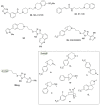Dopamine D3 Receptor Antagonists as Potential Therapeutics for the Treatment of Neurological Diseases
- PMID: 27761108
- PMCID: PMC5050208
- DOI: 10.3389/fnins.2016.00451
Dopamine D3 Receptor Antagonists as Potential Therapeutics for the Treatment of Neurological Diseases
Abstract
D3 receptors represent a major focus of current drug design and development of therapeutics for dopamine-related pathological states. Their close homology with the D2 receptor subtype makes the development of D3 selective antagonists a challenging task. In this review, we explore the relevance and therapeutic utility of D3 antagonists or partial agonists endowed with multireceptor affinity profile in the field of central nervous system disorders such as schizophrenia and drug abuse. In fact, the peculiar distribution and low brain abundance of D3 receptors make them a valuable target for the development of drugs devoid of motor side effects classically elicited by D2 antagonists. Recent research efforts were devoted to the conception of chemical templates possibly endowed with a multi-target profile, especially with regards to other G-protein-coupled receptors (GPCRs). A comprehensive overview of the recent literature in the field is herein provided. In particular, the evolution of the chemical templates has been tracked, according to the growing advancements in both the structural information and the refinement of the key pharmacophoric elements. The receptor/multireceptor affinity and functional profiles for the examined compounds have been covered, together with their most significant pharmacological applications.
Keywords: GPCR; dopamine; drug optimization; multi-targeting approach; receptor antagonists; selectivity.
Figures














Similar articles
-
Targeting the dopamine D3 receptor: an overview of drug design strategies.Expert Opin Drug Discov. 2016 Jul;11(7):641-64. doi: 10.1080/17460441.2016.1185413. Epub 2016 May 30. Expert Opin Drug Discov. 2016. PMID: 27135354 Review.
-
Bitropic D3 Dopamine Receptor Selective Compounds as Potential Antipsychotics.Curr Pharm Des. 2015;21(26):3700-24. doi: 10.2174/1381612821666150724100830. Curr Pharm Des. 2015. PMID: 26205291 Review.
-
Current drug treatments targeting dopamine D3 receptor.Pharmacol Ther. 2016 Sep;165:164-77. doi: 10.1016/j.pharmthera.2016.06.007. Epub 2016 Jun 22. Pharmacol Ther. 2016. PMID: 27343365 Review.
-
Dopamine D2 Receptors Dimers: How can we Pharmacologically Target Them?Curr Neuropharmacol. 2018 Jan 30;16(2):222-230. doi: 10.2174/1570159X15666170518151127. Curr Neuropharmacol. 2018. PMID: 28521704 Free PMC article. Review.
-
In vitro pharmacological profile of YM-43611, a novel D2-like receptor antagonist with high affinity and selectivity for dopamine D3 and D4 receptors.Br J Pharmacol. 1996 Apr;117(8):1625-32. doi: 10.1111/j.1476-5381.1996.tb15332.x. Br J Pharmacol. 1996. PMID: 8732269 Free PMC article.
Cited by
-
Discovery of CNS-Like D3R-Selective Antagonists Using 3D Pharmacophore Guided Virtual Screening.Molecules. 2018 Sep 25;23(10):2452. doi: 10.3390/molecules23102452. Molecules. 2018. PMID: 30257450 Free PMC article.
-
Trace amine-associated receptor 1 agonists RO5263397 and RO5166017 attenuate quinpirole-induced yawning but not hypothermia in rats.Behav Pharmacol. 2017 Oct;28(7):590-593. doi: 10.1097/FBP.0000000000000330. Behav Pharmacol. 2017. PMID: 28704278 Free PMC article.
-
Multitarget 1,4-Dioxane Compounds Combining Favorable D2-like and 5-HT1A Receptor Interactions with Potential for the Treatment of Parkinson's Disease or Schizophrenia.ACS Chem Neurosci. 2019 May 15;10(5):2222-2228. doi: 10.1021/acschemneuro.8b00677. Epub 2019 Jan 9. ACS Chem Neurosci. 2019. PMID: 30609891 Free PMC article.
-
Assessing NH300094, a novel dopamine and serotonin receptor modulator with cognitive enhancement property for treating schizophrenia.Front Pharmacol. 2024 Jan 24;15:1298061. doi: 10.3389/fphar.2024.1298061. eCollection 2024. Front Pharmacol. 2024. PMID: 38327987 Free PMC article.
-
Dopamine Receptors: Is It Possible to Become a Therapeutic Target for Depression?Front Pharmacol. 2022 Aug 17;13:947785. doi: 10.3389/fphar.2022.947785. eCollection 2022. Front Pharmacol. 2022. PMID: 36059987 Free PMC article. Review.
References
-
- Ananthan S., Saini S. K., Zhou G., Hobrath J. V., Padmalayam I., Zhai L., et al. . (2014). Design, synthesis, and structure-activity relationship studies of a series of [4-(4-carboxamidobutyl)]-1-arylpiperazines: insights into structural features contributing to dopamine D3 versus D2 receptor subtype selectivity. J. Med. Chem. 57, 7042–7060. 10.1021/jm500801r - DOI - PMC - PubMed
-
- Aragona B. J., Day J. J., Roitman M. F., Cleaveland N. A., Wightman R. M., Carelli R. M. (2009). Regional specificity in the real-time development of phasic dopamine transmission patterns during acquisition of a cue-cocaine association in rats. Eur. J. Neurosci. 30, 1889–1899. 10.1111/j.1460-9568.2009.07027.x - DOI - PMC - PubMed
Publication types
LinkOut - more resources
Full Text Sources
Other Literature Sources

